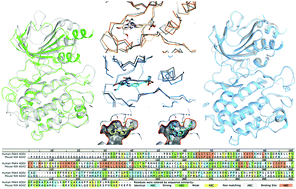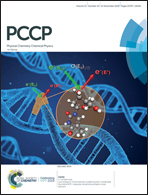Molecular dynamics simulation and QM/MM calculation reveal the selectivity mechanism of type I 1/2 kinase inhibitors: the effect of intramolecular H-bonds and conformational restriction for improved selectivity†
Abstract
Understanding the selectivity mechanisms of inhibitors towards highly similar proteins is extremely important work on the way to a new drug. Here, we aim to reveal the selectivity mechanisms of type I 1/2 kinase inhibitors towards p21-activated kinase (PAK4) and mitogen-activated protein kinase kinase kinase 14 (MAP3K14, NIK). PAK4, belonging to the serine/threonine protein kinases, is involved in cell signaling pathways and controls cellular functions and has received attention as an attractive drug target. The high sequence identity between PAK4 and NIK makes it challenging to design selective PAK4 inhibitors. In this work, computational methods including protein comparison, molecular docking, QM/MM, molecular dynamics simulations, and density functional theory (DFT) calculation were employed to explore the binding mechanisms of selective inhibitors against NIK and PAK4. The simulation results revealed the crucial factors accounting for selective inhibition of PAK4 over NIK, including different protein–ligand interactions, the positions and conformations of key residues, and the ligands flexibilities. This study will shed light on understanding the selectivity mechanisms of PAK4 and NIK inhibitors.



 Please wait while we load your content...
Please wait while we load your content...